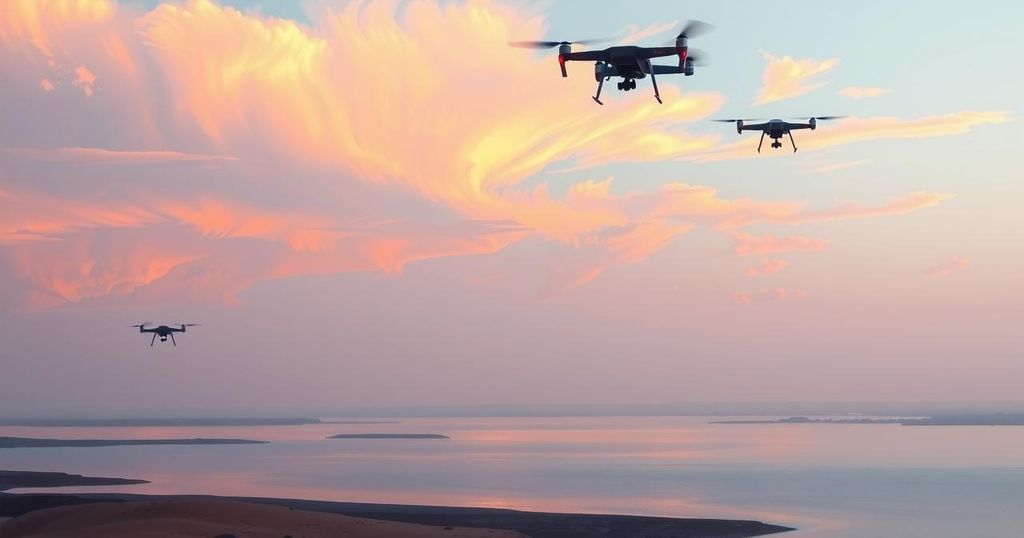The Rise of Drone Warfare among Insurgents: ISWAP’s Tactics in Lake Chad

The Islamic State West Africa Province (ISWAP) has marked a significant shift in its insurgency tactics through the deployment of armed drones in combat, notably in a December 2024 attack on a Nigerian military base. This new dimension raises pressing questions regarding the adaptability of regional counter-terrorism strategies and necessitates urgent enhancements in technology, intelligence sharing, and socio-economic interventions to address the evolving threat effectively.
Recent developments in the Lake Chad Basin highlight a significant escalation by the Islamic State West Africa Province (ISWAP), particularly with the introduction of armed drones in combat operations. The alarming event on December 24, 2024, involved an attack on Nigeria’s Forward Operating Base in Wajiroko, marking the inaugural deployment of drones by a terrorist group in this region, resulting in injuries to several soldiers.
This new phase in ISWAP’s strategy represents a troubling evolution in their tactics, as previous drone usage had primarily been for propaganda and surveillance. The changing dynamics of warfare have raised concerns over the adaptability of regional counter-terrorism efforts, particularly since the technology is now being weaponized, posing a formidable challenge to existing military operations.
Drone utilization by ISWAP is not isolated; it echoes trends observed among extremists in other locations like Somalia and Libya. Elevated drone capabilities signify a crucial shift in operational tactics, making aerial technology a significant component of insurgent strategies, thus requiring an urgent response from regional security forces.
Moreover, the sophistication of ISWAP’s armaments has also grown, with recent footage showcasing young recruits training with high-caliber firearms and being coached by foreign operatives. This access to advanced weaponry, along with technical support from Islamic State trainers, underscores the group’s intensified military capabilities and strategic foresight in combat planning.
Despite the existence of collaborative efforts such as the Multinational Joint Task Force (MNJTF), regional forces must urgently adapt to counter the evolving threats posed by ISWAP. Major General Godwin Mutkut, at the Maiduguri forum, noted the absence of counter-drone technology, which exacerbates civilian vulnerability to drone assaults, necessitating a reevaluation of existing defenses.
Furthermore, addressing the supply chain networks that facilitate ISWAP’s drone capabilities is crucial. Ex-fighters have indicated that access to drone technology is achieved through a mix of smuggling and arms trafficking. Hence, regional forces must engage in enhanced intelligence-sharing and operation coordination to disrupt these networks effectively.
To mitigate ISWAP’s ability to conduct drone warfare, it is imperative for regional governments to prioritize investment in counter-drone systems and to conduct preemptive strikes on identified ISWAP drone facilities. Simultaneously, long-term strategies should also be considered to address the socio-economic factors that enable ISWAP’s recruitment and radicalization efforts in vulnerable communities.
Collaboration with international partners can provide much-needed technical assistance and bolster regional capabilities to counteract ISWAP’s advancements, ensuring a comprehensive approach to mitigating the rising threats in the Lake Chad Basin.
In conclusion, the emergence of ISWAP’s use of armed drones marks a pivotal moment in counter-terrorism efforts in the Lake Chad Basin. This development emphasizes the need for regional forces to enhance their technological capabilities and coordination between nations. It remains critical to address both immediate tactical challenges and the longer-term socio-economic and governance issues contributing to the insurgents’ resilience.
Original Source: allafrica.com








